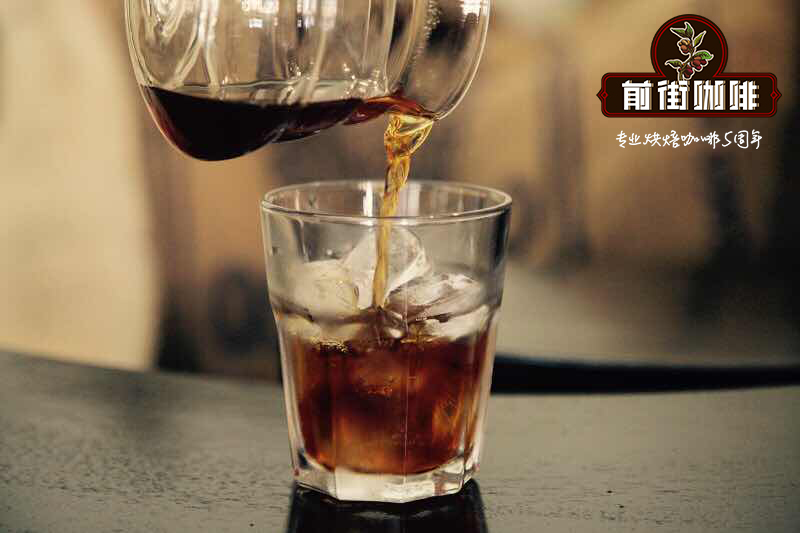Cold coffee is not difficult to make iced coffee like Starbucks lucky at home.

Professional coffee knowledge exchange more coffee bean information please follow the coffee workshop (Wechat official account cafe_style)
Cold-extracted coffee is extracted at low temperature, which can extract small molecules from coffee beans, so the flavor of coffee beans will be very obvious.
The trend of cold extract coffee (Cold Brew Coffee) has been in practice in the United States for many years, and with the expansion of Starbucks stores around the world, compared with the saturated cold coffee market in the United States, Europe obviously has a lot of room for improvement. However, according to the latest data released by Mintel, many new products of cold coffee appeared in Europe in the summer of 2017 and successfully attracted the attention of consumers.
In Europe, where coffee shops are extremely dense, almost every consumer has his own set of views on how to drink coffee, which makes European consumers known as the hardest group in the world to please. If new coffee products want to enter the European market, grandstanding gimmicks are absolutely not enough, which is why when cold-picked coffee is popular in the United States, there are still so few related products in the European market.
Unlike traditional coffee, which uses high-temperature extraction to extract the flavor of coffee beans, it is easy to make coffee bitter and scorched. Cold-extracted coffee is extracted at low temperature, which allows coffee powder to come into contact with low-temperature water for a long time, so the small molecules in coffee beans can be extracted. Therefore, the flavor of coffee beans itself will be very obvious, and taste more smooth, sweet.
In the summer of 2017, M ö venpick, a Swiss food company, took the lead in launching cold coffee in Europe and impressed European consumers with intensive TV commercials and large billboards. After that, many do-it-yourself films appeared on the Internet, teaching people how to make cold coffee at home. For European consumers who have always liked their own DIY, this can be said to be a challenge full of fighting spirit. It also indirectly allows the market for cold-extracted coffee to climb to another high-rise, whether it is cold-extracted coffee sold by coffee shops, canned cold-extracted coffee produced by food manufacturers, or cold-extracted coffee pots that can be made by themselves, begin to appear in large numbers in the European market, and bring full performance.
According to Mintel statistics, 44 per cent of consumers in Italy, which is best at drinking coffee, said they were interested in trying cold coffee, compared with 31 per cent in France and 51 per cent in Spain and Poland. In Germany, although only 27% of consumers said they were interested in cold coffee, 46% of the 34-year-old group in 25MMI.
Julia Buech, a German representative of Mintel Food and Beverage analyst, said that the success of cold extract coffee actually reflects that modern consumers have a great interest in food processing that subverts previous perceptions. In addition, coffee extracted at high temperature in the past is mostly bitter, and consumers are easy to unwittingly add too much sugar, while cold extract coffee tastes smooth and sweet, so some consumers think that drinking cold extract coffee is healthier. In addition, the concept of DIY has prevailed in recent years, and cold coffee is just in line with the two major trends of novelty and craftsmanship, which is also the reason for the rapid rise of the cold coffee market in Europe.
Important Notice :
前街咖啡 FrontStreet Coffee has moved to new addredd:
FrontStreet Coffee Address: 315,Donghua East Road,GuangZhou
Tel:020 38364473
- Prev

What is the authentic cold coffee? is the cold coffee a kind of iced coffee?
Professional coffee knowledge exchange more coffee bean information Please follow the coffee workshop (Wechat official account cafe_style) what is the difference between cold coffee and ordinary iced coffee, do coffee lovers really know? The following will define several types of iced coffee in detail. Watch this! Ice drop Coffee: this is a kind of instrument, invented in the Netherlands, so it is also called
- Next

Are there any precious coffees that are difficult to get on Kopi Luwak?
Professional coffee knowledge exchange more coffee bean information Please pay attention to Coffee Workshop (Wechat official account cafe_style) Kopi Luwak coffee is produced by the droppings of Indonesian coconut cats (a kind of civet) as raw materials, and all poop coffee is in the same way, using elephant droppings as raw materials to produce coffee. In fact, shit coffee is made by Blake D, a Canadian living in Thailand.
Related
- Beginners will see the "Coffee pull flower" guide!
- What is the difference between ice blog purified milk and ordinary milk coffee?
- Why is the Philippines the largest producer of crops in Liberia?
- For coffee extraction, should the fine powder be retained?
- How does extracted espresso fill pressed powder? How much strength does it take to press the powder?
- How to make jasmine cold extract coffee? Is the jasmine + latte good?
- Will this little toy really make the coffee taste better? How does Lily Drip affect coffee extraction?
- Will the action of slapping the filter cup also affect coffee extraction?
- What's the difference between powder-to-water ratio and powder-to-liquid ratio?
- What is the Ethiopian local species? What does it have to do with Heirloom native species?

